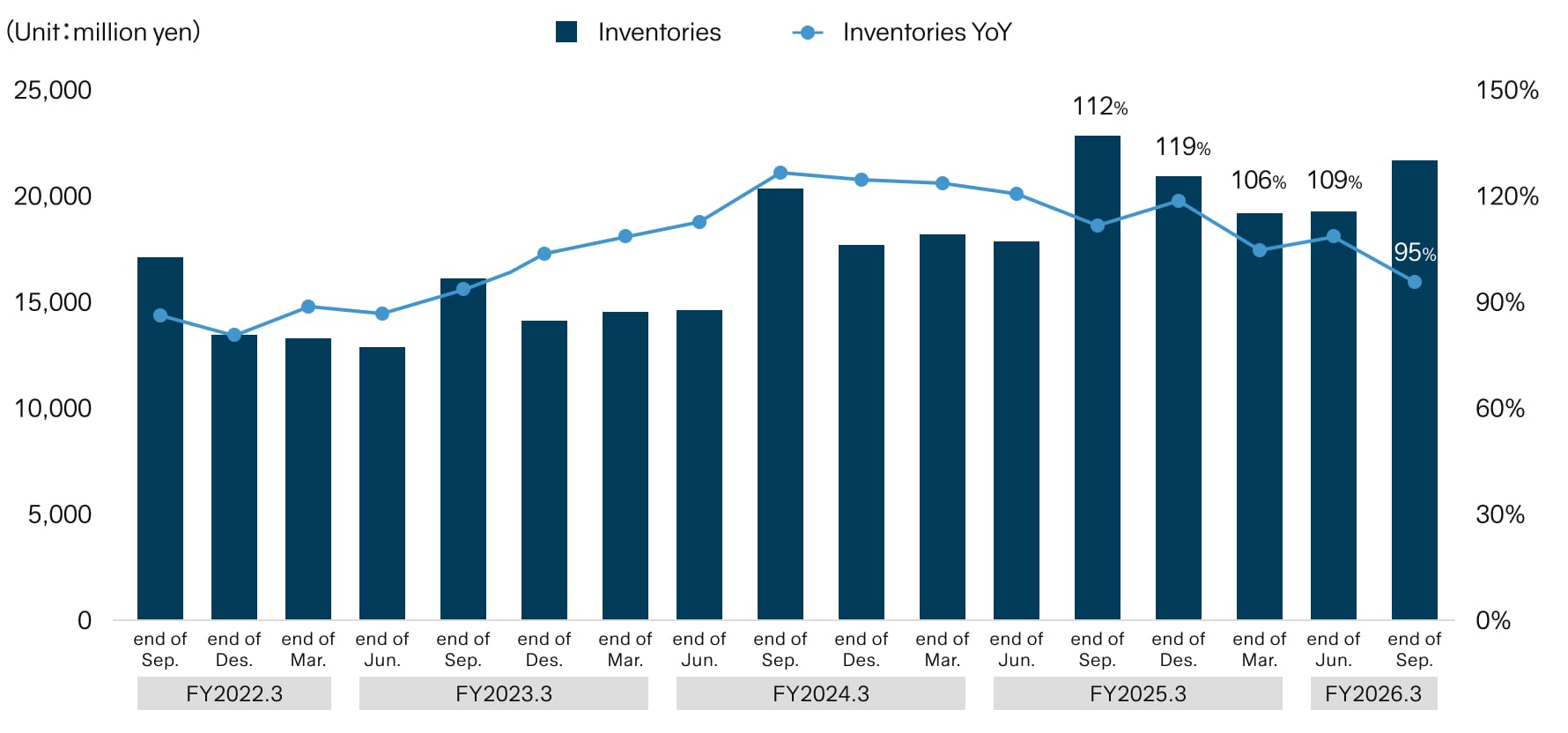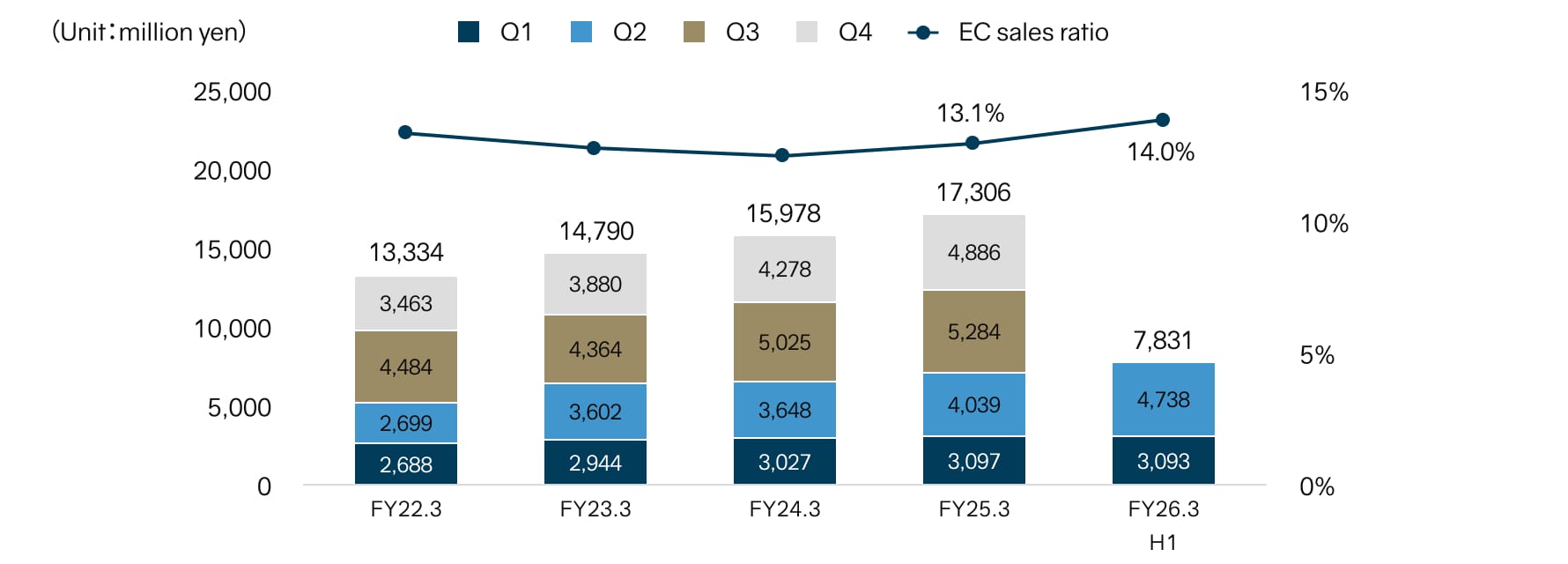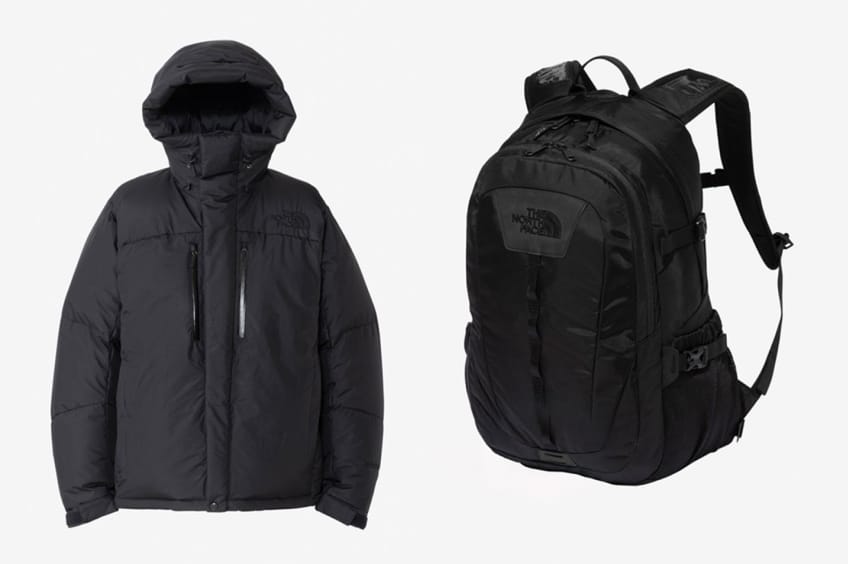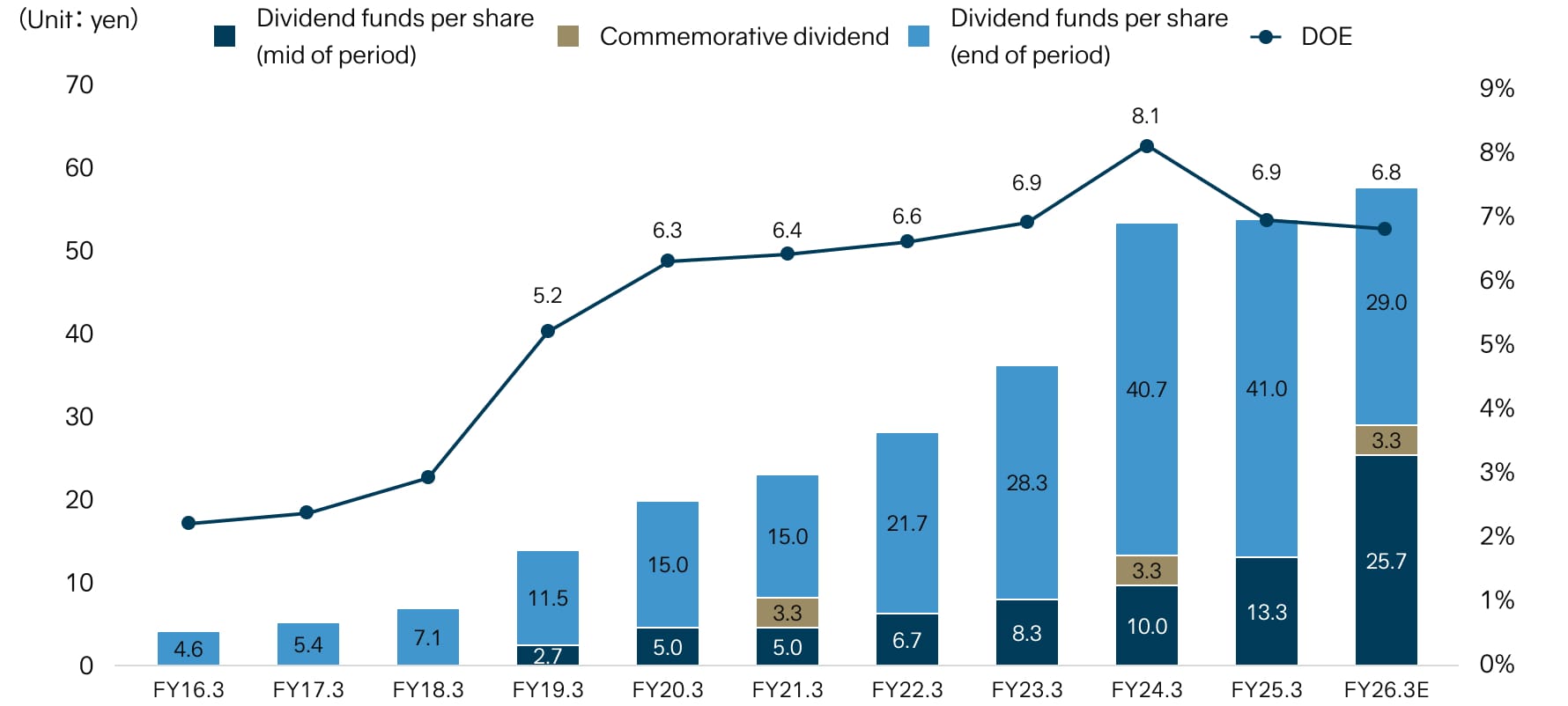Latest Financial Results Investors
RESULTS FOR FY2026.3 Q2
Summary of Financial Results
In Q2, our strategy of expanding large-format self-operated stores and renovating existing stores with more floor space was successful. This allowed us to create a product lineup that meets customer needs and implement in-store promotions that adapt to climate change. As a result, net sales increased YoY in every month from July to September.
On the other hand, items from ordinary profit downward decreased. This was because the share of profit (loss) of entities accounted for using the equity method from our equity-method affiliate, YOUNGONE OUTDOOR Corporation (YOC) in Korea, was impacted by exchange rate translation. However, we expect this impact to gradually decrease from Q3 onward, and there are no changes to our initial full-year plan.
| Net sales | Gross profit | Operating profit | Ordinary profit | Net income | |
|---|---|---|---|---|---|
| Results | 55,589 | 28,554 | 6,959 | 9,093 | 6,798 |
| YoY(H1 cumulative) | 104.2% | 107.2% | 133.5% | 91.7% | 86.4% |
| YoY(Q2 only) | 110.2% | 112.0% | 144.6% | 94.3% | 85.8% |
| Profit margin ()=Previous year’s results |
― | 51.4% (49.9%) |
12.5% (9.8%) |
16.4% (18.6%) |
12.2% (14.7%) |
Factors for Strong Net Sales and Adaptation to Climate Change
Continuing from Q1, net sales remained firm. This was driven by the success of our sales measures—such as opening new large-format stores in major urban areas and renovating existing stores with more floor space—which allowed us to meet customer needs based on region, temperature, and customer segment. In particular, the lifestyle segment, which emphasizes both functionality and design, was a key driver. This was led by the strong performance of high-functional products, mainly by THE NORTH FACE’s “Climate Adaptation Products,” which are adapted to climate change. These include thin shells and T-shirts that promote breathability and lightweight properties.
| Performance | Lifestyle | Fashion | |||||||
|---|---|---|---|---|---|---|---|---|---|
| Q1 | Q2 | H1 total | Q1 | Q2 | H1 total | Q1 | Q2 | H1 total | |
| Net sales | 7,846 | 8,805 | 16,652 | 13,751 | 18,837 | 32,589 | 1,947 | 3,435 | 5,383 |
| YoY(%) | 95.8% | 101.4% | 98.7% | 93.8% | 109.6% | 102.3% | 114.7% | 121.3% | 118.8% |
| YoY(millions yen) | (341) | +121 | (220) | (916) | +1,649 | +733 | +249 | +602 | +852 |
| Ratio to sales (%) | 33.3% | 28.3% | 30.5% | 58.4% | 60.6% | 59.7% | 8.3% | 11.1% | 9.9% |
Management Focused on Protecting the Gross Profit Margin
The gross profit margin was 50.2% for Q2 and 51.4% for the first half cumulative total. Despite a temporary decline due to seasonal factors (the clearance sale period), we are progressing as planned toward achieving the full-year target of 52.7%. We plan to continue improving our core profitability model by reviewing design costs and increasing the composition ratio of high-value-added products.
Gross profit margin trend

| Q1 | Q2 | 3Q | 4Q | Total | |
|---|---|---|---|---|---|
| FY24.3 Results | 50.6% | 51.0% | 56.3% | 51.8% | 52.9% |
| FY25.3 Results | 50.5% | 49.4% | 54.7% | 52.1% | 52.1% |
| FY26.3 Progress | 53.0% | 50.2% | ― | ― | E 52.7% |
| YoY | +2.5pt | +0.8pt | ― | ― | ― |
Strengthening Self-Managed Operations and Optimizing Inventory
Inventories at the end of September were at 95% YoY, a level below the same period last year. By responding to actual demand for spring/summer products and improving the accuracy of our order flow, our lean inventory management approach has become standard practice. We opened 10 new stores in the first half, including overseas, and plan to open stores in major cities in the second half, including London, Seoul, and New York City.
Our OMO strategy is also progressing. E-commerce net sales were 110% YoY for the first half cumulative total. By differentiating from other sales channels—such as with limited-edition colors and collaboration products available only at our self-operated stores and our own e-commerce site—we are achieving results through the integrated operation of our self-operated stores and online channels. Furthermore, we will implement e-commerce-specific sales strategies, such as launching “THE NORTH FACE WHITE LABEL”—planned by YOC—on our
e-commerce site starting in November.
Quarterly trend in inventories balance

E-commerce Net Sales Trend

Strengthening competitiveness by selling limited edition products.
Collaboration products, The North Face’s classic all-black collection (available exclusively through our own e-commerce site or select directly managed stores) and Limited-edition products rise in performance. Contributes to improving gross profit margin and brand value.

THE NORTH FACE WHITE LABEL expansions into Japan
This year, we will start again selling some of the products from “THE NORTH FACE WHITE LABEL”, which is popular in Korea, exclusively through our own e-commerce site.

Profit and Expenses
Operating Profit Increased, but Items from Ordinary Profit Downward Decreased. Expense Execution Partially Reviewed.
In Q2, operating profit increased YoY due to the impact of new store openings and control of SG & A expenses. However, because the share of profit (loss) of entities accounted for using the equity method from YOC decreased YoY due to exchange rate impacts, items from ordinary profit downward fell below the same period last year. The elimination of one-time expenses from the previous year (3.5 billion yen in the previous year) is advancing our transition to a structural profit constitution.
Regarding SG & A expenses, we are currently scrutinizing and optimizing expense execution for the second half based on our expense execution results through the first half.
| Item | YoY increase after deducting one-time expenses ➀ |
Q1 YoY increase ② |
Q2 YoY Increase amount ➂ |
First half total ④=②+➂ |
Second half revised forecast ⑤=⑥-④ |
Full year revised forecast ⑥ |
Difference from initial forecast ⑦=⑥-➀ |
Special Notes |
|---|---|---|---|---|---|---|---|---|
| Advertising expenses | +7 | +2 | +2 | +3 | +7 | +10 | +3 | In the second half, there will be an exhibition celebrating the 25th anniversary of the E-commerce and SUMMIT series. |
| Personnel expenses | +18 | +2 | +3 | +5 | +10 | +15 | (3) | Delays in mid-career recruitment. Other than that, everything proceed as planned. |
| Rent fee | +6 | +4 | 0 | +4 | +4 | +8 | +2 | Increase in overseas store openings, etc. |
| Depreciation | +1 | +1 | 0 | +1 | (1) | 0 | (1) | Progressing within plan. |
| Business activity expenses | +10 | +1 | +3 | +4 | +3 | +7 | (3) | Scrutiny of consulting contracts, etc. |
| Logistics expenses | +1 | 0 | 0 | 0 | +1 | +1 | 0 | Increase in logistics volume. |
| Others | +3 | +1 | +1 | +3 | +2 | +4 | +1 | Progressing within plan. |
| Total | +46 | +11 | +9 | +20 | +25 | +45 | (1) | Although there may be increases or decreases depending on the item, the total amount is expected to be executed as planned. |
Toward 15th Consecutive Dividend Increase, Including Commemorative Dividend for 75th Anniversary
We plan for an annual dividend of 58 yen per share (29 yen interim and 29 yen year-end), which includes a 75th-anniversary commemorative dividend, marking our 15th consecutive dividend increase. We will maintain a stable DOE, and the total payout ratio is expected to exceed the previous year. By maintaining the dividend level even after the 1-for-3 stock split, we have clarified our stance on strengthening shareholder returns.
Dividend per share and DOE(Dividend on equity ratio) *After the stock split

Figures shown are post-stock split, as a 3-for-1 stock split of common stock was conducted with an effective date of October 1, 2025.
A commemorative dividend of 3.3 yen (10 yen pre-split) was paid in FY2021.3 and FY2024.3.
The interim dividend for FY2026.3 includes a 75th-anniversary commemorative dividend of 3.3 yen (10 yen pre-split). The year-end dividend is planned to be an ordinary dividend of 29 yen per share, bringing the total annual dividend to 58 yen.